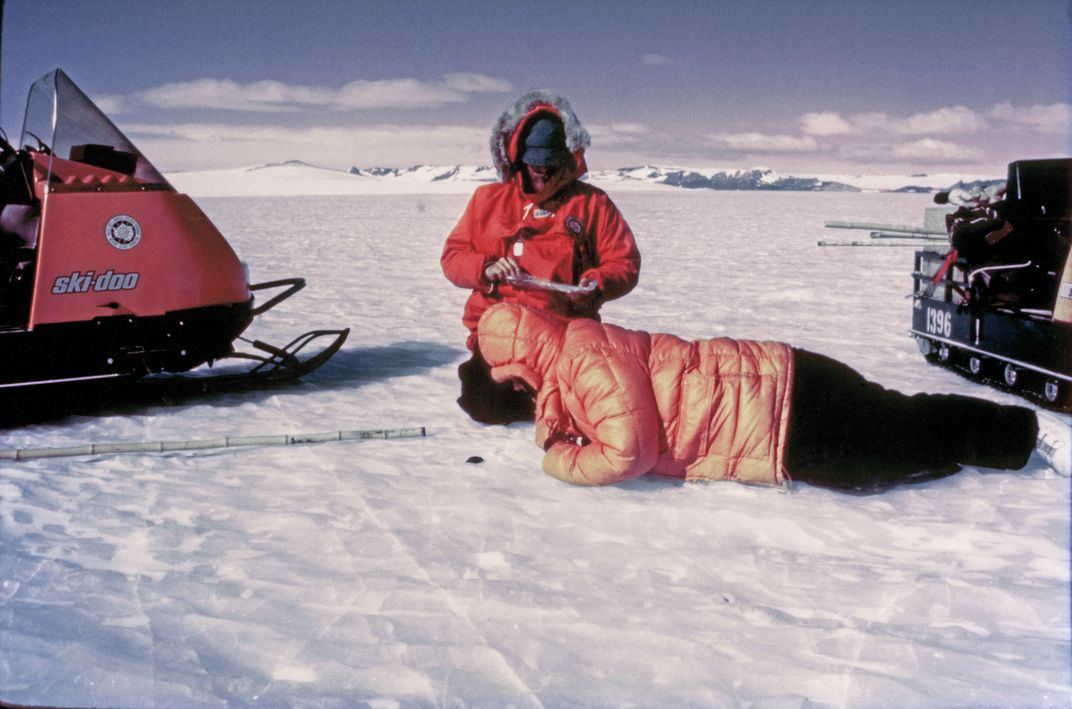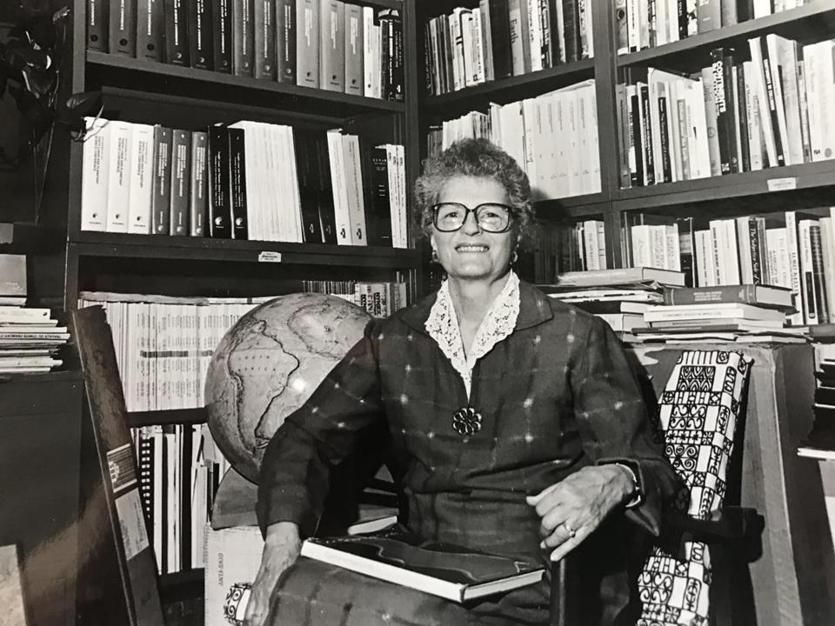The Rockstar Geologist Who Mapped the Minerals of the Cosmos
A professor told Ursula Marvin she should learn to cook. Instead she chased down meteorites in Antarctica
/https://tf-cmsv2-smithsonianmag-media.s3.amazonaws.com/filer/99/d0/99d07c85-a57f-45e0-93e0-d9a1f470625c/sia2015-002618.jpg)
At the age of 57, geologist Ursula Marvin traveled to Antarctica to hunt for meteorites, the first woman to ever do so.
Marvin, who died on February 12 this year at the age of 96, described her time there with an air of wonder. “Working in Antarctica is a marvelous experience. We tented and searched in the gorgeous mountainous regions,” she said in a 2001 interview. Conditions that most people would find grueling, the longtime Smithsonian scientist delighted in: “By dressing for the cold we kept comfortable, and I loved having 24 hours of daylight.”
In a way, Marvin had been preparing for such an adventure all her life. As a woman in a male dominated field—geology—she had weathered gender barriers throughout college and embraced years of fieldwork in Brazil and Africa. And after extensive study of lunar samples from NASA’s historic Apollo missions, she had acquired the knowledge and tenacity needed for an Antarctic expedition. Poised on the icy tip of the terrestrial, Marvin was ready to uncover the mysteries of the cosmic.
Born Ursula Bailey in August of 1921, she was the youngest in a family of three in the Vermont countryside. Her entire family shared a love of nature, perhaps stemming from the fact that they grew up next to the Connecticut River with a view of the White Mountains of New Hampshire just to the east. “Best of all was just after sunset when a breathtaking alpenglow lit up the mountains in shades of peach and purple,” she recalled in the 2001 interview.
Her father, an entomologist with the Department of Agriculture, and her mother, a schoolnteacher, valued education. They always expected their children to go to college. When Marvin’s turn to choose a college came around, she “felt adventurous,” and unlike her siblings, applied to colleges hundreds of miles from home. Eventually, however, she chose her father’s alma mater, Tufts College, built on a hill overlooking Boston. Even at a school that close to home, she found adventure for herself, skiing down the steep hill on snowy evenings.
“One thing I felt certain of was that I never would want to be a scientist,” Marvin said, recalling her early college days. She decided to pursue history but was also required to take two full years of science. Biology didn’t make much of an impression on Marvin, but from the very first lecture of professor Robert Nichols’ geology class, she said that she was “spellbound.” She recalls how Nichols, “a speaker of immense force, began talking about continents and oceans and how they have changed and evolved over long periods of time.”
Soon after that first geology class, Marvin decided to change her major from history to geology. Yet although Nichols’s words had so inspired her, she encountered a shock when she told him her decision. “No, you cannot major in geology,” she recalled him saying. “You should be learning how to cook.” Undeterred, Marvin continued to fulfill the requirements for a history degree while taking myriad geology courses with a quiet resolve.
In an interview with Smithsonian.com, Karen Motylewski, who later worked with Marvin at the Harvard-Smithsonian Center for Astrophysics, described Marvin as “strong-willed and determined.” As a woman in a male-dominated field, Marvin “had to fight pretty darn hard for her position in the field—and did” said Motylewski, “but she did so in a very quiet and polite way.”

Marvin had already resolved to navigate for herself a field that was not welcoming to women. But luck brought her a fortuitous female mentor in her journey. When Nichols left Tufts in the midst of World War II, geologist Katharine Fowler-Billings took his place, and became a female role model who helped Marvin imagine herself as a professional geologist. After meeting Fowler-Billings, Marvin recalled thinking “now I knew that women geologists existed.”
Marvin’s encounter with Billings illustrates the importance of having representation of women in science. But after more experience in such a masculinized field, Marvin also understood mere presence of women was not enough to retain them in the sciences.
Decades later, after gaining some renown of her own, Marvin would help organize a 1975 “Space for Women Conference,” which helped young women prepare for careers in science; she also became the first Women’s Program Coordinator at Smithsonian Astrophysics Laboratory in 1974. In 1976, she co-authored an article titled “Professionalism Among Women and Men in the Geosciences,” in which she helped identify five obstacles, on top of lack of role models, to women succeeding in science.
After graduating, Marvin applied to Radcliffe for graduate study in geology, and attended with a full scholarship in 1943. Within her first year, she had a research assistantship with Esper S. Larsen studying uranium ores for a Manhattan Project grant. This made her the first woman research assistant in Harvard’s geology department—followed by another first, when geologist Kirtley Mather hired her as a teaching assistant to teach introductory geology classes.
In 1946, Marvin graduated from Radcliffe and went to the University of Chicago with her first husband, who was attending Northwestern Dental School. While there, she found work as a research assistant helping to create artificial feldspars (a group of minerals that contain calcium, sodium, or potassium and making up over half of the earth’s crust). Both her marriage and time in Chicago was short, however, and she moved back to Cambridge in 1950 to begin her PhD in geology, focusing on mineralogy. There, she met fellow geologist Tom Marvin. On April 1, 1952—the same day that her divorce from her first husband was final—she married Tom.
The first years of her new marriage, too, Marvin called an “adventure.” The pair worked together as prospectors for manganese oxide deposits in Brazil and Angola for the Union Carbide Corporation. They left for South America before she could finish her doctoral oral exams at Harvard, but the opportunity for world travel and hands-on fieldwork was indispensable in preparing her for the more demanding exhibitions to come.
By the time Marvin returned to Harvard in 1956, the Space Race was in full swing. In this changed political atmosphere, she found a new and thrilling use for her mineralogical skills—not in mines, but in star stuff.

In 1956, Marvin joined a team studying the mineral makeup of the meteorites in the Harvard collection. At the same time, she was also offered a position teaching mineralogy at Tufts from an unlikely person: Robert Nichols, the same professor who had told her she should be learning to cook instead of learning geology. She worked in both roles until her position with the meteorite team turned into permanent civil service job at the Smithsonian Astrophysical Observatory (SAO), which would occupy her until her retirement in 1998.
In 1969, the same year that three Apollo missions successfully landed on the moon, Marvin and her colleague John Wood at SAO began to study lunar samples collected from Apollo 11. Their petrological and mineralogical research group investigated tiny rock fragments from the lunar soil, and “Ursula was the mineralogy arm of it,” Wood tells Smithsonian.com.
In their study, the group found something they did not expect: white anorthosite, which is likely to form during the early stages of magma cooling. “The savants who had worried about what the moon was made of, how it was formed, what it all meant, prior to the Apollo missions people were wrong,” Wood says. “They had said the moon formed relatively cold and didn’t really have a violent igneous history. And the evidence from these particles we found showed that that was wrong.”
The presence of white anorthosite proved that a young moon was either mostly or completely melted. Marvin, Wood, and two others from the research group published this finding about the mineralogical makeup of the lunar surface in a 1970 article in Science. Of their work on lunar samples, Wood says, “I like to think that the work that our group did, that Ursula was a part of, was the most important contribution that any of us made.”
Six years after these findings, American-led team began exploring Antarctica for meteorites, which had been found by Japanese scientists in 1973 embedded in the Arctic sheet in large concentrations. After learning of the expeditions, she immediately wanted to go and personally sought out the expedition leader, William Cassidy, and asked him to include her on the team. And she did go—twice—for the austral summer in 1978-79 and again in 1981-82, collecting dozens of meteorites to discover more about the mineralogical makeup of these celestial objects.
“I think she found her great joy when the exploration of Antarctica for meteorites began,” Motylewski says. Further bolstering her mineralogical expertise, Motylewski says that “Ursula had an eye for and looked for the unusual, what didn’t fit. So she was, I think, instrumental in helping identify those meteoritic pieces, which came from other planetary sources.”
(It should be noted that, despite her vast accomplishments, Marvin's scientific contributions were relatively inaccessible to the general public until recently. In 2015, that changed when one of the Smithsonian Institution’s annual Women in Science Wikipedia Edit-a-Thons initiative created a page for her on the editable online encyclopedia. The initiative has resulted in the creation of more than 50 new articles on groundbreaking geologists, anthropologists, botanists and more.)
The Antarctic expeditions from various countries including the U.S. have returned thousands of meteorites with origins in the Moon and even Mars. Marvin’s work in these efforts was rewarded and is now memorialized with Marvin Nunatak named for her in Antarctica, as well as Asteroid Marvin. With a mountain peak in the Arctic and an asteroid zooming through space bearing her name, Marvin leaves a legacy as a geologist of the boundless and as a ceaseless adventurer.
Marvin had few regrets about her career. When a friend once suggested to her that she would have been happier if she had stuck with history, she, with such certainty, replied, “I cannot agree to that. I really would not exchange for anything our work in Brazil and Angola, or the thrill of seeing those first samples from the Moon, or of spotting black rocks on the Antarctic.”
